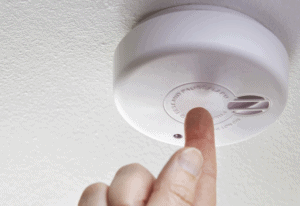 In a modern stove, a flue expels the gases from the burning wood, which keeps you warm. The flue is carefully designed to ensure smoke and gases leave the fire without any discomfort or inconvenience to yourself.
In a modern stove, a flue expels the gases from the burning wood, which keeps you warm. The flue is carefully designed to ensure smoke and gases leave the fire without any discomfort or inconvenience to yourself.
Smoke can sometime enter a room from a stove, if there is a downdraft, or if the rope sealant on the fire window has failed. You quickly become aware of this, as stoves are usually only in operation when someone is around. But what happens if there is a fire in a home, which is not planned? A smoke detector can be the different between life and death.
We always strongly recommend a fire alarm and a carbon monoxide detector in a home. In this article we are considering the key things you should pay attention to when getting a smoke alarm.
8 safety tips for your fire alarm:
.
- One smoke alarm isn’t enough, you need at least two.
- Make sure any alarms you buy are marked with a current British Standards or European (CE) safety mark.
- A smoke alarm should be fitted on a ceiling or high up on a wall.
- If there is a fire risk in a room, that room should have a fire alarm.
- Always read the instructions when using a new system.
- Only screw into the ceiling/wall. Sticking on with glue can damage the alarm, and make it really difficult to take off (for cleaning, changing battery).
- Fit a heat alarm in the kitchen, not a smoke alarm, as cooking etc will constantly set the smoke alarm off.
- Opt for a smoke alarm with a 10 year or long-lasting sealed battery.
Whats the difference between a heat alarm and fire alarm?
A heat alarm goes off when a room reaches a certain temperature. They are good in rooms like the bathroom or kitchen, where a smoke detector would be set off by the smoke or steam. Heat alarms are as easy to fit as a smoke detector and cost from around £5 upwards.
Smoke and fire alarms – good things to know:
.
- Fit them in all rooms where there is a fire risk, don’t just fit them in your hall and landing.
- Use heat alarms in the kitchen and bathroom.
- Some battery or mains alarms can be interlinked. So when an alarm detects a fire, they all go off. This will give you a warning wherever you are in the house, essential if you live in a very large property, where a single fire alarm in a different room may not be heard.
- If you go for a mains fitted smoke alarm, make sure it’s fitted by a qualified electrician.
If you don’t have a fire alarm (or heat alarm/carbon monoxide detector), don’t delay – get one fitted now. If you have one, ensure it works correctly. Using an extended vacuum hose to suck away any residual dust, which can affect the sensors is good to do from time to time.








